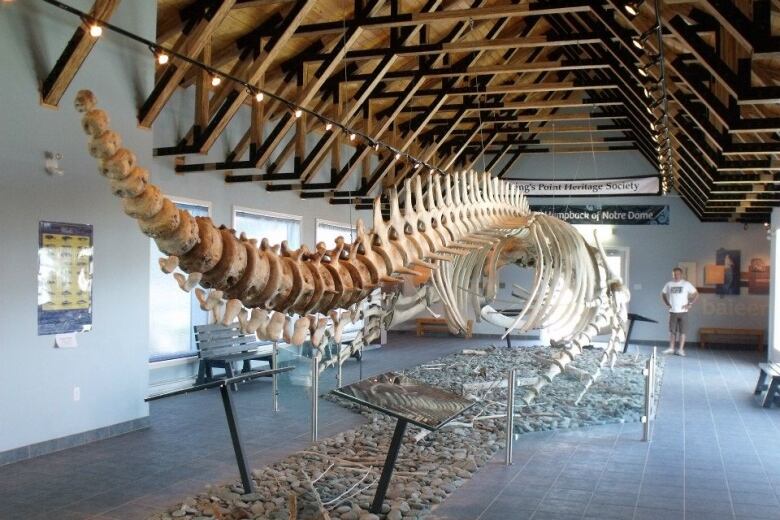Rotting blue whale carcass should stay, says Trout River woman
Team of 10 from Royal Ontario Museum to arrive in Trout River in next few days
The plan to let two blue whales go to a Toronto museum is not going over well with the owner of a restaurant in Trout River, the western Newfoundland townwhere one of the whale carcasses came ashore last month.
Last month, at least nine blue whales were caught in the ice off the southwest coast of Newfoundland and died.

On Thursday, the Royal Ontario Museum announced it will send a team to western Newfoundland to prepare two whale carcasses for transport to Ontario.The Department of Fisheries and Oceans reached a deal for the museum to take possession of the whales that are rotting on beachesin Trout River and Rocky Harbour.
Jenny Parsons, who owns the Seaside Restaurant in Trout River, said the skeletons could be a tourist attraction if they stay in the town.
"The town now already [has] got a couple of little museums there on the boardwalk so there is property there that can be expanded. It don't have to be huge but it could house that blue whale skeleton."
There are very few blue whales available for study and they are now extremely rare.- Mark Engstrom, Royal Ontario Museum
She told the CBC's As It Happens that she hopes residents fight the plan to move to whales to Ontario.
"If we fight as a community, does that mean [the Department of Fisheries and Oceans] turns its back and says, 'OK, we tried to help. To hell with you guys. You're on your own, figure it out.' And we're stuck with a dead whale on our beach in the middle of July," Parsons told host Carole Off on Thursday night.
Parsons said the whales should be put on display in thecommunity.
"The irony of it is two days ago government said, 'It's your whale Trout River, it's your problem. [It's a] once in a lifetime opportunity.I was on the boardwalk there last night and thepeople I talked to were allgungho. Can you imagine if there was a blue whale exhibit in our town?It would attract people from all over the world. We are happy thatDFOhas stepped up to the plate, but we're not so happy that Ottawa is going to take from us again."
Parsons told Off other towns on the island have dealt with whale carcass removal and preservation before.

The Town of King's Point, in central Newfoundland, opened a whale pavilion in 2010.In January 2001, a 15-metre female humpback whale was retrieved from fishing gear by a group of volunteers near Cobb's Arm. Nine years later, the skeleton was put on display as the centrepiece of the Dr. Jon Lien Whale Pavilion. Thefacility is similar to the Sperm Whale Pavilion in Triton, also in central Newfoundland, home to a12-metre skeleton of a deep diving sperm whale.
The town now already [has] got a couple of little museums there on the boardwalk so there is property there that can be expanded.- Jenny Parsons, owner of Seaside Restaurant in Trout River
Parsons said the whale carcass has been garnering a huge amount of international attention. Media outlets around the world have beencurious to know the status of the rotting mammal.
"The phone's been ringing off the hook. I just got off the phone from Sydney, Australia ... to a journalist out of Japan ...I've been talking to Londontoday. I think a lotof the hype has to do with thinking this whale is going to blow up. But I'm not so sure that's going to happen. The whale is not as tight as it was."
Parsons said she has already contacted TV show host Ellen DeGeneres and scientist David Suzuki, looking for help.
Big, expensive and smelly operation
Meanwhile, Royal Ontario Museum deputy director Mark Engstrom said very few blue whales are available for study.
There are fewer than 250 adultblue whales in the Northwest Atlantic population. The mammals are estimated to weigh between 100 and 150 tons.
Engstrom said this is a big deal.
"You know, we feel it's a duty to the scientific community to be able to preserve the specimens that have come on shore, because they're so rare and it's a very unusual opportunity to preserve them."
Engstrom said the process will be a big, expensive and smelly job,but an important one.
"It's very important for the scientific research community to have specimens that they can study. There are very few blue whales available for study and they are now extremely rare."
Engstrom said the skin, blubber and organs will be removed from the whale.
The skeleton will be taken apart, and then the bones will be transported to Ontario on a truck.He added it will be sometime before they're on public display.













_(720p).jpg)


 OFFICIAL HD MUSIC VIDEO.jpg)
.jpg)



























































































